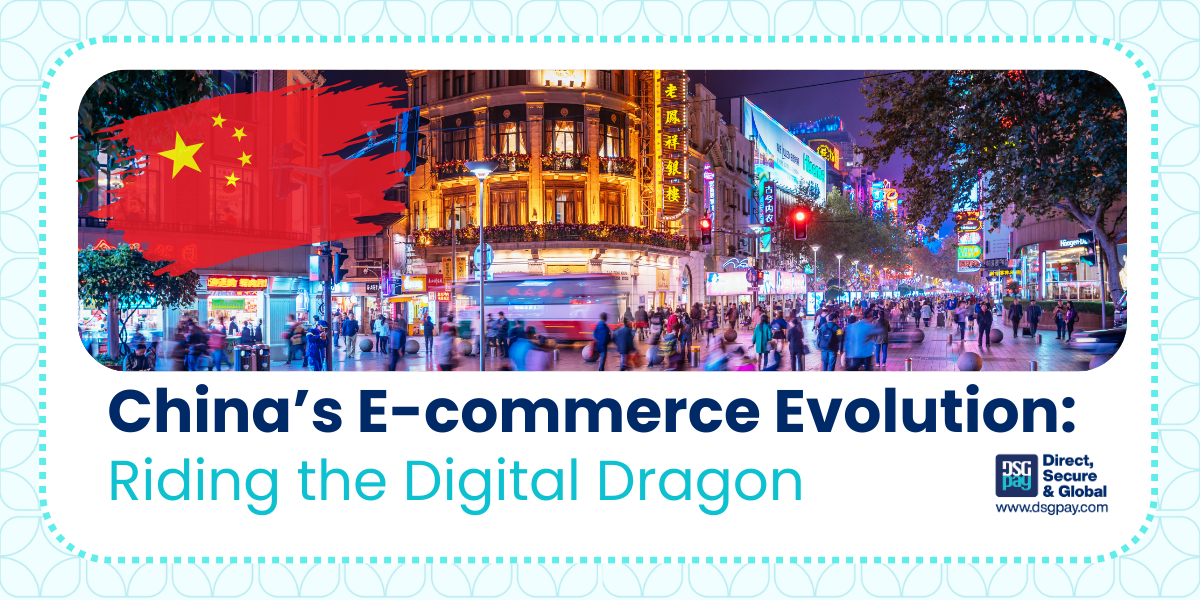From its humble origins to its current status as a global powerhouse, China’s e-commerce journey has been nothing short of remarkable. The world’s most populous country isn’t just shaping global e-commerce trends – it’s China’s e-commerce evolution that is rewriting the playbook.
Let’s deep dive into this fascinating journey, the lessons it offers, and the potential speed bumps on its digital superhighway.
Table of Contents
From Humble Beginnings to a Global Powerhouse
Tracing the journey from its modest origins to its current global dominance, we begin with a flashback to the year 2000, when China’s e-commerce evolution was in its infancy, met with scepticism about its potential.
China now dominates more than half of global e-commerce sales. Giants like Alibaba, JD.com, and Pinduoduo spearheaded this transformation, building digital ecosystems that cater to every consumer need. Their growth story is one of agility, relentless focus, and innovation—turning China’s e-commerce into a global benchmark.
Innovations That Define China’s E-commerce Landscape
What makes China’s e-commerce unique is its bold embrace of technology and creativity. Here are the standout innovations driving its success:
1. Live Streaming: Shopping Meets Entertainment
Platforms like Taobao Live and Douyin have revolutionized online shopping. Live streaming enables influencers and brands to interact with audiences in real time, turning shopping into an engaging, social experience. It’s a perfect blend of entertainment and instant purchasing decisions.
2. Social Commerce: Trust Through Community
While most countries have clear demarcations between social media and e-commerce platforms, China blurs the lines. Platforms like Xiaohongshu (Little Red Book) combine user-generated content, reviews, shared experiences, and shopping in a single platform. This organic mix of social interaction and e-commerce has made product discovery more community-driven and trust-centric.
3. AR and AI: Enhancing User Experience
User-centric design is at the heart of China’s E-commerce evolution. Platforms deploy AR for virtual try-ons, allowing consumers to sample products, from clothes to cosmetics, in a virtual space. The AI-driven recommendation systems have reached unprecedented levels of accuracy, ensuring consumers find products tailored to their preferences.
4. Integrated Ecosystems
WeChat, originally a messaging app, epitomises the power of integrated ecosystems. Today, it’s a one-stop solution, from messaging to shopping, payments, ride-hailing, and even wealth management. This ecosystem approach ensures users remain within the platform, increasing transaction volumes and enhancing customer convenience.

Market Dynamics: The Tectonic Shifts in China’s E-commerce Evolution
- Rural Market Expansion: With improved logistics and connectivity, rural China has emerged as a burgeoning e-commerce market.
- Consumer Evolution: The Chinese consumer isn’t just digitally savvy. They’re discerning, value-driven, and, importantly, eager to embrace innovation.
- Cross-Border E-commerce: Platforms like Tmall Global allow international brands to tap into the Chinese market without a physical presence, fostering global commerce.
Shaping China’s E-Commerce: Consumer Trends and the Power of Feedback
1. Consumer Trends
As digital natives come of age, their shopping habits, driven by values and experiences, are dictating market trends.
- Sustainability and Ethical Shopping: Brands emphasising green practices or ethical production find favour among younger consumers.
- Experiential Shopping: It’s not just about the product but the experience. Virtual fitting rooms or online cooking classes accompanying ingredient sales add layers to simple transactions.
- Niche Markets Thrive: From indie beauty brands to specialised tech gadgets, niche markets cater to a new age of informed, discerning consumers.

2. The Power of Feedback
Chinese e-commerce platforms have masterfully integrated feedback mechanisms into their systems, turning every critique into an opportunity.
- Instant Iterations: Real-time feedback leads to immediate iterations, whether in product design or digital interface.
- Community-driven Commerce: Platforms often rely on community reviews, discussions, and recommendations, driving trust and transparency.
- The Personal Touch: Advanced AI ensures that feedback isn’t just collected but also personalised, enhancing user experience at every step.
The Road Ahead: Potential Challenges
Despite its success, China’s e-commerce faces challenges that test its adaptability:
- Regulatory Rigor: With its e-commerce boom, China has also amplified its regulatory scrutiny, ensuring that giants don’t wield unchecked power. Recent antitrust regulations bear testimony.
- Growing Competition: Niche platforms are rising, fostering innovation but also fragmenting the market.
- Logistics and Infrastructure: Despite advancements, ensuring timely deliveries across such a vast nation with varied topographies remains a challenge.
Lessons for the World: The Global Takeaway
When extracting global insights from China’s e-commerce evolution, the lessons learned are invaluable:
- Agility Drives Success: China’s e-commerce behemoths weren’t always gigantic. Their agility, ability to pivot, and unrelenting focus on consumer needs drove their growth.
- Integration is Key: Building integrated ecosystems where services complement each other enhances user retention and spending.
- Data Powers Innovation: Chinese platforms leverage data not just for sales but for personalisation, market trends, and product development enhancing both business and customer satisfaction.
- Embracing Mobile-first Strategies: Unlike Western markets where e-commerce began on desktops, China’s mobile-first approach revolutionized the sector. QR codes have democratized digital payments, and super apps like WeChat epitomize the seamless integration of multiple services. Even mobile gaming has been harnessed to drive e-commerce, blending entertainment with shopping to maximize user engagement.
Final Thoughts
As China’s e-commerce landscape continues to evolve, the lessons learned are not just valuable for local players but for businesses globally. From the rise of mobile-first strategies to the integration of feedback loops and the shift toward value-driven consumerism, the Chinese market has set a new standard for the digital economy.
At DSGPay, we are inspired by these dynamic shifts and are committed to applying these insights to optimize our global payment solutions.



